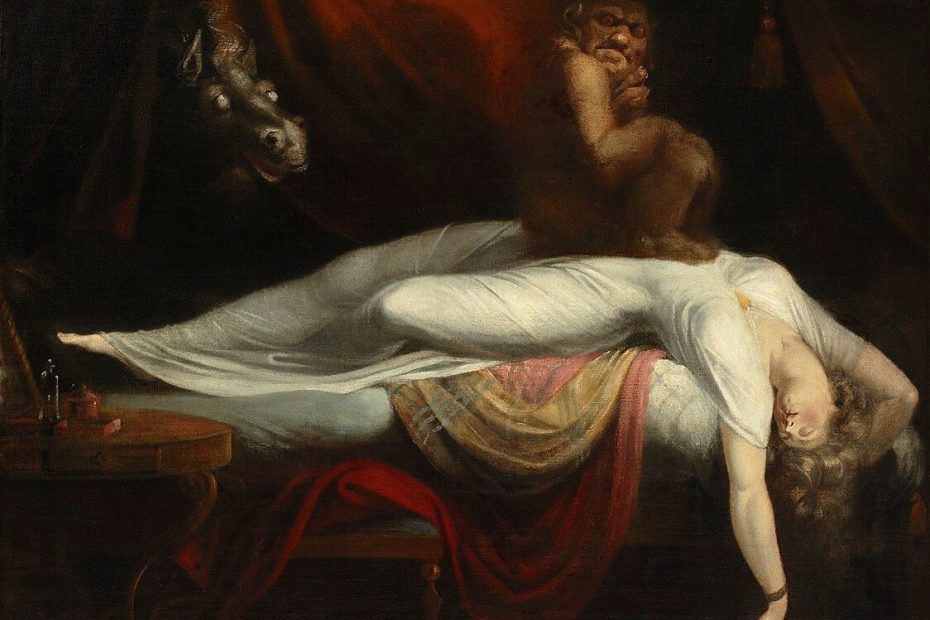Above: The Nightmare by Henry Fuseli (1781) is probably the best-known artistic depiction of sleep paralysis.
It’s a scene straight out of a horror movie. You lay in bed, your eyes open. In the corner of your eye, you can see a dark figure standing by your bedroom wall. Slowly, the figure begins approaching you. You try to jump up and run, but find your body is glued to the bed. You cannot move, even as the figure approaches closer and closer. …
Then, suddenly, everything is back to normal. You sit up and look around. There is no figure in the room, just emptiness. You have just experienced sleep paralysis.
What is sleep paralysis?
Sleep paralysis is the sensation of being unable to move while experiencing frightening visions or sensations. The phenomenon has been described since ancient times, and was historically associated with demons, ghosts or possession.
Sensations experienced during an episode of sleep paralysis can come in many forms. Many hear sounds like whispering, humming and hissing. Others feel intense pain or a pressure on the chest. The latter is so common that it was often featured in folklore as a demon, witch or hag that sits on people’s chests to suffocate them. Some people feel themselves being lifted or flown out of their beds, and many people who have reported alien abduction may have actually experienced sleep paralysis.
What causes sleep paralysis?
There are many hypotheses on the cause of sleep paralysis. The best supported is dysregulation of the rapid eye movement (REM) stage of the sleep cycle. This is the stage in which we have dreams, but are unable to move our muscles. If there is an overlap between this REM dreaming stage and wakefulness, sleep paralysis may occur. This may be why sleep paralysis usually occurs while falling asleep or waking up, hypnagogic and hypnopompic sleep paralysis, respectively.
Who experiences it?
Sleep paralysis is a remarkably common experience, with around 7%–8% of the population experiencing sleep paralysis at least once during their lifetime. Interestingly, sleep paralysis sometimes runs in families, so there may be a heritable component to the terrifying episodes. Additionally, sleep paralysis seems to be linked to conditions like narcolepsy, supine (back) sleeping, irregular sleep schedules, sleep deprivation, certain medications and substance abuse.
How is sleep paralysis different from other issues with sleep?
Several other sleep-related disorders are similar to sleep paralysis. One is nightmare disorder, which is the occurrence of frequent nightmares. Although they’re both related to issues with the REM stage of sleep, there isn’t an awareness of the environment in nightmare disorder. Night terrors are like nightmares, but they occur during a stage of deep non-REM sleep, and cause people to awaken suddenly in fear, unable to remember what terrified them.
Is there a treatment?
There are several treatment options for people who experience recurrent episodes of sleep paralysis. Cognitive behavioral therapy can help reconstruct thoughts related to sleep paralysis, and may help reduce these episodes. Medications can also aid people who suffer from recurring episodes. Tricyclic antidepressants and selective serotonin reuptake inhibitors may be helpful by possibly decreasing the duration of the REM stage of sleep. Lastly, changes to improve sleep hygiene may reduce episodes of sleep paralysis. These changes can be as simple as establishing a sleep routine, avoiding a late dinner, unplugging from electronics early, and finding ways to wind down and relax before going to bed.
Related Content
- Sleep May be a Curious Piece in the Alzheimer’s Disease Puzzle (Part 1)
- Clinical Trial Shines Light on Sleep Disorders in Blind Patients
- The Science of Snoring
Want to read more from the Johns Hopkins School of Medicine? Subscribe to the Biomedical Odyssey blog and receive new posts directly in your inbox.

Never was interested in this topic until started struggling with sleep paralysis myself. There are plenty of useful studies on the topic that could help - https://ivypanda.com/essays/sleep-is-a-vital-stage-of-a-day-cycle-in-humans/ - but unfortunately, they are not suitable for everyone. Do you have any additional tips to the ones you already mentioned in the post?
Comments are closed.